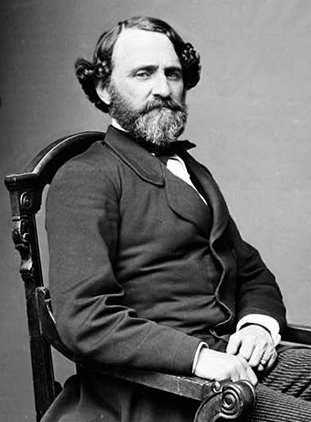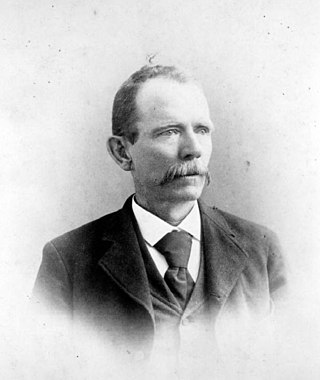Related Research Articles

Green Mount Cemetery is a historic rural cemetery in Baltimore, Maryland, United States. Established on March 15, 1838, and dedicated on July 13, 1839, it is noted for the large number of historical figures interred in its grounds as well as many prominent Baltimore-area families. It retained the name Green Mount when the land was purchased from the heirs of Baltimore merchant Robert Oliver. Green Mount is a treasury of precious works of art, including striking works by major sculptors including William H. Rinehart and Hans Schuler.

Francis Asbury "Berry" Hendry was a Florida cattle rancher, politician, and military officer in the Confederate States Army during the American Civil War. He was an influential figure amongst the Seminole living on reservations in Polk County, and near Fort Myers, Florida. Hendry was also a state senator for parts of Lee County, Hendry County, and Collier County, as well as serving as a state representative for Lee County for six terms from 1893 to 1904. He was known by the nickname "Berry."

Lexington Cemetery is a private, non-profit 170-acre (69 ha) rural cemetery and arboretum located at 833 W. Main Street, Lexington, Kentucky.

John Forsyth Jr. was an American newspaper editor of the Mobile Register and the son of politician John Forsyth.
The modern history of Tampa, Florida, can be traced to the founding of Fort Brooke at the mouth of the Hillsborough River in today's downtown in 1824, soon after the United States had taken possession of Florida from Spain. The outpost brought a small population of civilians to the area, and the town of Tampa was first incorporated in 1855.

Newnansville, Florida was one of the first American settlements in the interior of Florida. It became the second county seat of Alachua County in 1828, and one of the central locations for activity during the Second Seminole War, during which time it was one of the largest cities in the State. In the 1850s, the Florida Railroad bypassed Newnansville, resulting in the county seat being moved to the new town of Gainesville in 1854. Consequently, Newnansville began to decline, and when a second railway bypassed the town in 1884, most of its residents relocated and formed the new City of Alachua. By 1900, Newnansville was deserted.

Florida participated in the American Civil War as a member of the Confederate States of America. It had been admitted to the United States as a slave state in 1845. In January 1861, Florida became the third Southern state to secede from the Union after the November 1860 presidential election victory of Abraham Lincoln. It was one of the initial seven slave states which formed the Confederacy on February 8, 1861, in advance of the American Civil War.

Oaklawn Cemetery is the first public burial ground in Tampa, Florida, United States. The location was deeded in the mid-19th century and was described as the final resting place for "White and Slave, Rich and Poor." Oaklawn Cemetery is located at the intersection of Morgan Street and Harrison Street in downtown Tampa, about two blocks South of I-275. It has approximately 1,700 graves.
William Henry Tibbs was a Tennessee attorney and politician who served in the Confederate States Congress during the American Civil War. He was noted as a firebrand States' Rights advocate and Southern secessionist as well as being the last surviving member of the Confederate Congress till his passing in 1906.

James McKay Sr. was a cattleman, ship captain, and the sixth mayor of Tampa, Florida. McKay is memorialized with a bronze bust on the Tampa Riverwalk, along with other historical figures prominent in the History of Tampa.
Canter Brown Jr. is an American historian, professor and author. He was born in Fort Meade, Florida, and earned his degrees at Florida State University. He has taught at Florida A&M University and has worked at Fort Valley State University in Fort Valley, Georgia. He wrote a book about Florida's African American public officials from 1867 until 1924.
James T. Magbee, known as J. T. Magbee, was a pioneer of Tampa, Florida, the town's first lawyer, and the federal collector of revenues at Tampa. Magbee was a Florida State Constitutional Convention delegate, a Florida State Senator, a newspaper editor and a judge of the Circuit Court. He owned slaves prior to the Civil War.
Augustus Steele was a Florida entrepreneur, a Florida state legislator, and helped found Hillsborough County.

James Gettis was a lawyer and judge in Tampa, Florida. He was the second lawyer in Tampa. Gettis was also a city councilman, and state representative, and the first town clerk.

William Benton Henderson was a cattleman, merchant, and prominent figure in the history of Tampa, Florida. He is the namesake of Henderson Boulevard and Henderson Avenue as well as the former W. B. Henderson Elementary School.
John Gill Landrum was a Baptist pastor from Spartanburg, South Carolina, the namesake of Landrum, South Carolina. He signed the South Carolina Ordinance of Secession.

David Porter Hogue, also known as D. P. Hogue, was an American reporter and politician from the state of Florida. Hogue served as the 4th Florida Attorney General from 1848 until 1853. He also served various terms as Mayor of Tallahassee.
William Iredell Turner, also occasionally and erroneously referred to as William J. Turner, was a Florida pioneer and a soldier who helped establish Bradenton, Florida and Parrish, Florida.

William H. Kendrick known as Captain Bill Kendrick was a soldier, state senator, pioneer and lecturer in Florida. He has been referred to as "the original Florida cracker". Kendrick, Florida is named for him. He is also credited with naming Orlando.

Franklin Guest Smith was a career officer in the United States Army. A Union Army veteran of the American Civil War, Smith also served in the American Indian Wars and the Spanish–American War, and attained the rank of brigadier general.
References
- ↑ "Rowell's American Newspaper Directory". July 6, 1873 – via Google Books.
- ↑ Bender, Shelby Jean Roberson; Dunham, Elizabeth Laramie (April 24, 2013). Tampa's Historic Cemeteries. Arcadia Publishing. ISBN 9780738598536 – via Google Books.
- ↑ Tampa in Civil War and Reconstruction by Carter Brown Jr. Page 14
- ↑ Denham, James M. (April 24, 1997). A Rogue's Paradise: Crime and Punishment in Antebellum Florida, 1821-1861. University of Alabama Press. ISBN 9780817308476 – via Google Books.
- ↑ "The Florida peninsular". ufdc.ufl.edu.
- ↑ "palmetto.htm". floridahistory.org.
- ↑ Hazen, Pauline Brown (1914). The Blue Book and History of Pioneers, Tampa Florida (PDF). p. 30. Archived from the original (PDF) on 2018-12-11. Retrieved 2019-06-22.
- ↑ "Meroba Hooker Crane « Tampa Riverwalk".